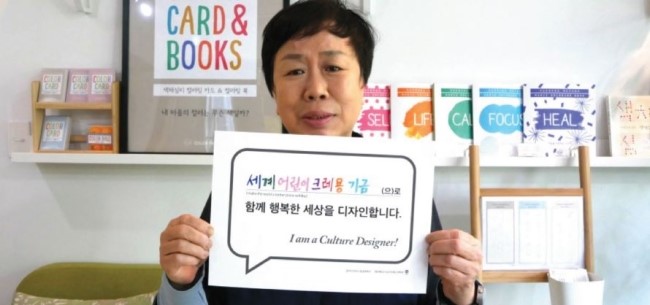|
Children in some parts of the world are exposed to perils such as disasters and terrorism. They are left to suffer deep emotional wounds. In our society, many children face issues such as disease, abuse, and violence at school. To stop these obstacles from hindering their future, the scars must be healed.
We met Paik Nak-sun, the head of World Children’s Crayon Foundation, who approaches suffering children with crayons. She tries to sow the seeds of hope and help them dream of their future through colors.
| |
 |
|
| ▲ Paik Nak-sun, Head of World Children’s Crayon Foundation |
What activities do the World Children’s Crayon Foundation focus on?
At the World Children’s Crayon Foundation we focus on providing color therapy programs to children who need help with healing their emotional scars. Children who defected from North Korea, those with multicultural backgrounds or handicaps, victims of school violence and disasters, as well as anyone with psychological scars.
Our experts in chromatherapy, called “crayon rescuers,” do art activities with the children and help them express their emotions with colors to heal their mental health.
Also, in the parts of the world we can’t reach, we send a variety of art supplies such as crayons, paint, color pencils, and pastels through our “crayon delivery project.” We help the children in the world get the opportunity to draw freely and express their suffering in colors so they can release their emotions to heal their scars.
I’m not familiar with the concept of “color therapy program.” How do you provide psychotherapy through colors?
Since “colors” surround all of our memories, observing colors and using them can make you remember certain emotions and events. Our memories can’t be the same, and everyone feels differently about each color. For instance, if we think of the color “red,” some people may be reminded of strong feelings like passion or rage, but others might think of sorrow. The image and the meaning of colors tend to form according to individual experience and memory. We don’t force these feelings and meanings onto children with emotional wounds. We help them remember what comes to their minds when they think of certain colors, discover what that feeling was like in the past, and help them with anything if they need assistance to heal their hearts.
The symbolic instrument for “World Children’s Crayon Foundation” would be the crayon. Is there any special significance to it?
Just because we have “crayon” in our name doesn’t mean that we only use them. We provide all kinds of art supplies that can express diverse colors, such as paint, color pencils, pastels, and markers. We thought the word “crayon” was the most reminiscent of childhood and innocence, the most appropriate representation of the children we work with. As I said before, each child feels and sees colors differently, so we need instruments that express various colors. Having the crayon as our symbol represents art activities involving children and an array of colors.
| |
 |
|
| ▲Coloring school for Children |
What are some principles that participants of World Children’s Crayon Foundation must abide by?
The concept of “freedom” for adults and children may be very different. The adults may think that a piece of paper and a crayon is all they need to “draw freely.” But it can be burdensome to the children. Instead, we provide the children with physical and mental freedom to draw anything they want when they are actually ready to start drawing. The children gradually begin to learn the freedom to do as they wish, use the supplies they want to try, and draw the art they want. Without being tied down to stereotypes, they learn how to express their minds and emotions to their hearts’ content and feel relieved.
What is your plan or the ultimate goal in the future?
Since we have produced many expert “crayon rescuers” through the World Children’s Crayon Foundation, we want to meet more children and broaden the range of our care. I want to try the “on-the-road atelier car,” where I get a large car with crayon rescuers and directly reach the locations in need.
Through our activities, I hope more people will find who they are and realize how unique and precious they are in the world. Once they recognize their own importance, they will naturally respect others, which in turn will create a happy world for everyone. |





















